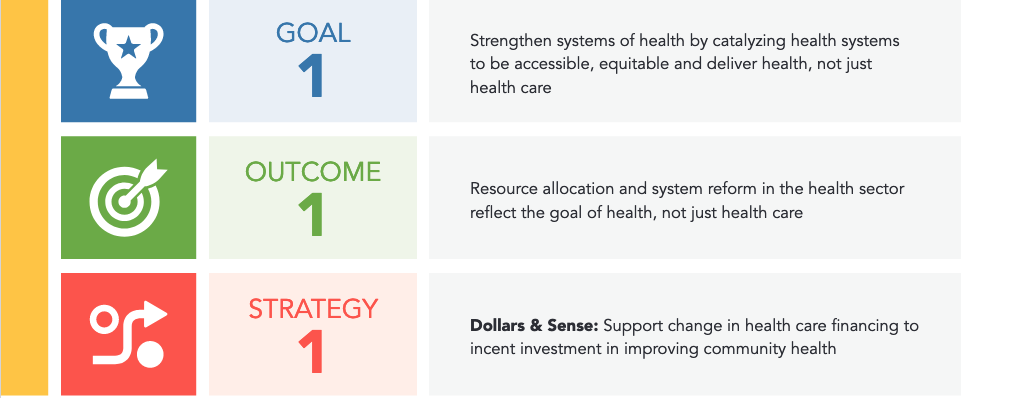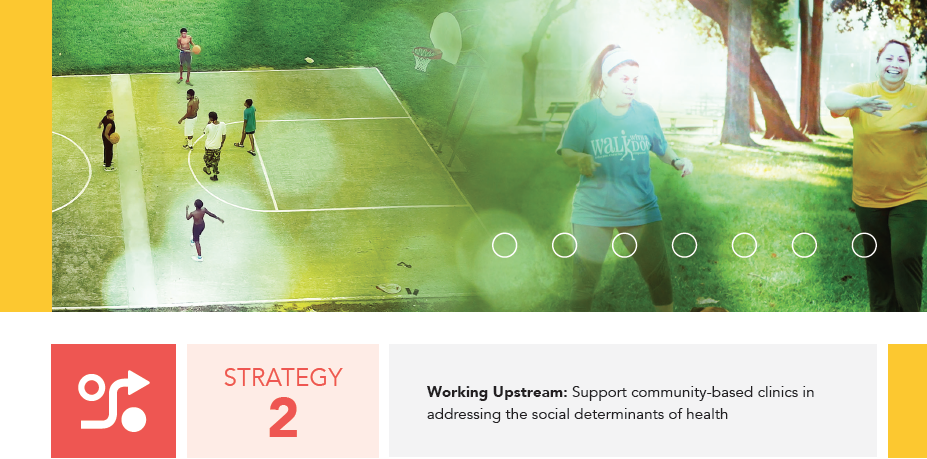

EHF desires to work with institutions that are willing to look at new ways of paying for improved health outcomes. We invite proposals that address innovative programs to pilot, transition, and scale approaches that change the way in which positive health outcomes are financially rewarded.
Examples of the types of investments EHF has considered under this strategy include, but are not limited to, the
following:
• Pay for success initiatives
Piloting models that incent spending on prevention by inviting private sector investors to bear up-front costs as well as risk of failure
• Incenting investment in social determinants of health
Working with Texas Medicaid, local governments, managed care organizations, and other payors to align value-based payment program incentives and other payment structures with interventions that address social determinants of health
• Multi-sector, health-focused community collaboratives
Supporting collaboratives that are testing innovative sustainable funding models such as CAPGI and Wellness Funds

Social determinants of health (SDOH) are broadly defined as the conditions in which people are born, grow, live, work and age and may include economic stability, neighborhood and physical environment, education, food, community and social context, and the healthcare system. EHF is interested in incenting clinics to target these upstream factors that influence population health and promote health equity beyond what the healthcare system has historically been able to address on its own.
EHF will continue to support the Community Centered Health Home (CCHH) practice. We encourage participating clinics to continue their CCHH work and consider ways in which that work can advance policy, systems, and environmental changes where appropriate.
For clinics interested in learning about and adopting the CCHH practice, multi-year funding may be used to create a glidepath to assist clinics in learning and adopting its principles and practices. We anticipate that during the first year, clinics will learn to recruit and engage clinic leadership including physicians, staff, and board members, identify and outreach to community service agencies with whom to partner, analyze data based on research of population/community health issues and the social determinants that impact them, to form the basis for developing a plan that moves the community to action.
Clinics will have access to the following online resources and tools:
• CCHH Logic Model
• CCHH Principles and Practices
• Healthy Places Toolkit: A Practical Guide to Improving Community Health
• Access to academic and foundation articles relating to community health models and community resource referral platforms
• Access to community engagement facilitation tools and resources and finally,
• Connection with current CCHH participating clinics who can support new clinics with their learning and serve as trusted resource to answer questions
Clinics interested in adopting the CCHH practice must speak with a Program Officer in advance of submitting a Letter of Inquiry.

EHF will continue to prioritize the Clinics Pathway Approach (CPA) that builds clinics’ fundamental capacities for population health work and value-based payment system design (please see CPA Logic Model). Please note, clinics currently participating in the CPA learning cohort do not need to reapply for continued CPA funding. Your Program Officer will reach out to assist with any necessary modifications to your existing application prior to consideration by the EHF board. We will not be accepting LOIs or applications from additional clinics. If your clinic is not currently in the CPA initiative and you are interested in developing activities that mirror the CPA initiative, please contact grants@episcopalhealth.org.
EHF will continue to support clinics to provide the full spectrum of comprehensive primary care though priority will be given to support:
Comprehensive reproductive health services
Guided by the World Health Organization’s definition of reproductive health – increasing access to, expanding accountability, and improving quality of reproductive healthcare including, but not limited to:
- Breast and cervical cancer screening (including mammography)
- Family planning/contraception
- Sexually Transmitted Infection screening and treatment
- Transgender care
- Adolescent reproductive care (including that offered in the pediatric practice)
- Perinatal care (including preconception, prenatal,
postpartum, and pediatric care)”
We refer applicants to the Centers for Disease Control and Prevention Providing Quality Family Planning Services (QFP) guidelines for evidence-based reproductive health resources to inform this work. Additionally, the Robert Wood Johnson Foundation convened national health leaders to launch the Raising the Bar project—a framework for advancing health equity and reproductive health justice.
EHF prioritizes work that addresses equity within reproductive health services by being responsive to the individualized needs of clients and addressing bias and discrimination within the healthcare system. Hence, we also call particular attention to the critical importance of culturally respectful, client-centered, and client-driven approaches to reproductive health service.
Integrated behavioral health services
EHF’s focus is bringing behavioral health services into a primary care setting, bringing primary care services into a behavioral health setting, or bringing substance use disorder (SUD) services into either a primary care or a behavioral health setting. The SAMHSA (Substance Abuse and Mental Health Services Administration) Center for Integrated Health Solutions has developed a framework to help primary and behavioral healthcare provider organizations improve outcomes by helping them understand where they are on the integration continuum. Applicants interested in applying for this priority should review this website when developing their proposals.
We are particularly interested in IBH approaches that attend to the unique needs of expectant people and primary
ers of children in the first three years of life.
Organizational Partnerships
For clinics interested in partnering with other clinics to optimize service delivery, operational strength or improve financial stability, proposals should outline the partnership and path towards service consolidation. Before such a grant is approved, a Memorandum of Understanding between/among the clinics must be executed.

This strategy is aimed at those living in smaller towns and rural areas. EHF is interested in work that increases the availability of basic preventive, primary, behavioral, and oral health services that are connected to the broader community and health system.
Examples of this work include but are not limited to:
• Offering technical assistance or operating support for rural health clinics to provide outpatient primary care services
• Developing approaches to recruit and/or retain provider staff including nurse practitioners and other mid-level providers
• Enhancing use of information technology and data analytics
• Supporting other practices that improve the sustainability and function of rural health clinics
A new priority in this Strategy is support for Health Resource Centers (HRCs)–organizations that facilitate access to health care by coordinating social service agencies that address various social determinants of health. HRCs may also provide technical assistance, information, tools, and resources for the improvement of rural health.
Similarly, Family Resource Centers are community centers that provide access to comprehensive and direct services to support families. Each center is unique in that it is designed to reflect the specific needs of the community, its culture, and interests. Research and planning grants to develop such a community center would be a potential opportunity for funding.
EHF will continue support grants for behavioral health services in non-integrated settings because we recognize the relative lack of behavioral health services in these locations.

EHF will fund clinics and community-based organizations to help low-income populations gain access to care through enrollment in health insurance and other health-related programs, including those offered by federal, state, and local governments. Funds will support dual approaches that expand health insurance coverage and improve enrollment of eligible beneficiaries, and advocacy efforts to increase health insurance coverage in Texas including the expansion of Medicaid.
EHF is particularly interested in:
- Proposals that use innovative approaches to track newly-enrolled beneficiaries through their first use of those benefits, most commonly through a visit with a medical provider or utilization of closed loop referral processes.
- Strategic partnerships that expand the enrollment ecosystem with key community partners such as schools, to find children and family members who could be eligible for health insurance coverage and other community benefits.
- Community engagement strategies to enhance consumer understanding of health benefits, identify health issues, develop local priorities and expand enrollment to new service areas such as rural communities.
- Innovative uses of strategic outreach, field navigators and partnership engagement specialists as part of the enrollment team to increase the ability to perform field enrollments and expand engagement to uninsured eligible individuals.
Organizations may also consider efforts that strengthen the enrollment eco-system by including advocacy supports that increase health insurance coverage in Texas, technical assistance supports that build the capacity of enrollment assisters, and efforts that maximize the impact and strengthen the work of enrollment-based coalitions.